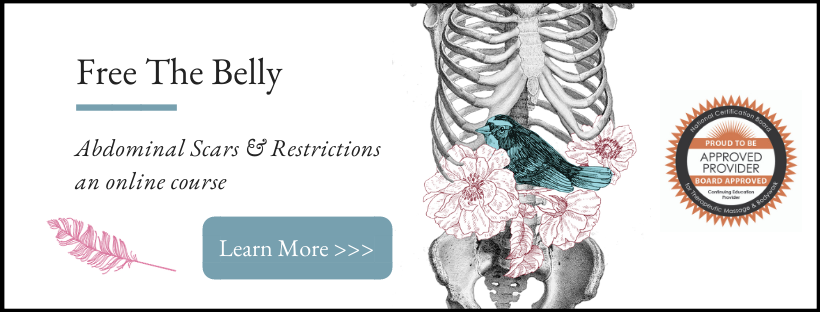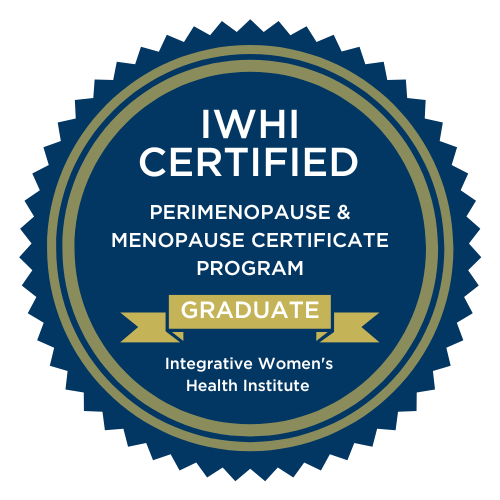“A scar from surgery is like an iceberg in that only 10% of it is visible at the surface. Think about and investigate all the deeper levels which have been cut and sewn together!” -Jean-Pierre Barral, D.O.
A c-section scar will accompany adhesions. Adhesions are fibrous bands that cause internal abdominal or pelvic tissues to stick together. The adhesions form in a way that binds tissues together that should otherwise naturally slide and glide. Adhesions form due to infection, inflammation, injury, and are a common complication from surgery. Adhesions may vary from thin strands or wide webs to dense fibers. These adhesions can cause abdominal and pelvic pain, fertility issues, bowel obstruction, trapped fluid, negatively affect the surrounding organs (bladder and intestines) and even change how the cells of an organ act via mechanotransduction (the conversion of mechanical stimuli into chemical activity). Severe adhesions can also affect posture. The body will “hug” lesions in the body. I’ve seen people side-bend around deep abdominal adhesions because it was a more comfortable position for them.
A complication of pregnancy following a previous cesarean birth, also known as c-section, is a placenta accreta. “Placenta accreta is a serious pregnancy condition that occurs when blood vessels and other parts of the placenta grow too deeply into the uterine wall. … It’s also possible for the placenta to invade the muscles of the uterus (placenta increta) or grow through the uterine wall (placenta percreta).” – Mayo Clinic.
According to latest statistics from the American College of Obstetricians and Gynecologists (ACOG),
“The incidence of placenta accreta has increased and seems to parallel the increasing cesarean delivery rate. Researchers have reported the incidence of placenta accreta as 1 in 533 pregnancies for the period of 1982–2002 (5). This contrasts sharply with previous reports, which ranged from 1 in 4,027 pregnancies in the 1970s.”
During a C-Section, a surgeon must first cut through nine different types of tissue layers before even getting to the uterus! The layers consist of the skin, superficial fascia (fatty and fibrous layer), deep fascia, rectus sheath, rectus abdominis (usually they separate the two halves along the linea alba rather than cut the muscle, but sometimes they have to cut the muscles if the baby is too large), transversalis fascia, extraperitoneal connective tissue, and peritoneum. The incision direction varies depending on the layer. Some layers are separated using surgical tools and some using fingers to bluntly separate the tissues. Therefore adhesions can form in complex webs. That’s why skin rolling over scar tissue may not be enough to affect the deeper and surrounding complex layers in a precise enough way. Each person is unique (tissue health, constitution, load patterns, nutrition, inflammation, past trauma, etc.) and each surgery has a different set of circumstances that influences suture patterns and how adhesions form, and to what extent they form. The surgeon may or may not suture the peritoneum closed.
How can you tell if you have adhesions? “Adhesion occurs in more than 90% of the patients following major abdominal surgery and in 55-100% of the women undergoing pelvic surgery. Small-bowel obstruction, infertility, chronic abdominal, and pelvic pain, and difficult reoperative surgery are the most common consequences of peritoneal adhesions. Despite elaborate efforts to develop effective strategies to reduce or prevent adhesions, their formation remains a frequent occurrence after abdominal surgery.” Source
In the study titled, A reliable way to predict intraabdominal adhesions at repeat cesarean delivery: scar characteristics, they found that the appearance of the scar (flat, raised, depressed, or pigment of the scar) is an indicator of the severity of intraabdominal adhesions.
When to receive Visceral Manipulation™: once the incision heals in all the tissue layers, typically 6-8 weeks, but that timeframe may be longer for some people, so check with your doctor to make sure it’s ok to receive abdominal therapy. In the meantime, don’t forget that you have a natural internal release mechanism called the breath. Often times we avoid breathing into areas of pain or trauma. It’s our way of “not going there”, but that area needs our gentle presence. Gentle full breaths naturally allow the tissues to move, even as far down as the pelvic area.
I teach breathwork, abdominal massage, exercises, and other supportive therapies for those with abdominal scars & restrictions in the Free the Belly Online Course.
If you missed my first article on Abdominal Adhesions, you can read it HERE.

![By Created by Uwe Kils (iceberg) and User:Wiska Bodo (sky). [GFDL (http://www.gnu.org/copyleft/fdl.html) or CC-BY-SA-3.0 (http://creativecommons.org/licenses/by-sa/3.0/)], via Wikimedia Commons Iceberg](https://upload.wikimedia.org/wikipedia/commons/thumb/a/ac/Iceberg.jpg/256px-Iceberg.jpg)








Barbara, why they took only pregnant women (and only high pregnant women) in the study to predict abdominal adhesions according to the scar? It is not valid method on non pregnant one?
Because the women were having c-sections anyway, so it gave them a chance to look inside and evaluate the adhesions. They wouldn’t open someone up without reason.
Some surgeons consider doing a vertical c-section instead of a horizontal one, as this does not cut across the meridians (as in Chinese Medicine), making for faster recovery.
On another point, Perhaps worth considering is using Hypnotherapy may be used prior to abdominal surgery to prevent adhesions. I have seen dentistry without any anaesthetic used and amputations too.
Thank you.
Reflexology would be well worth considering, to help ease adhesions and discomfort after an operation site has had time to recover. Usually performed on the feet, but can also be done on the hands too.
Does your work apply to women who have been through hysterectomy? Many thanks.
Yes, it does.